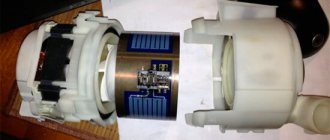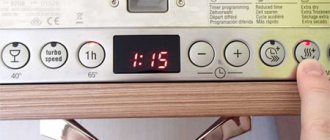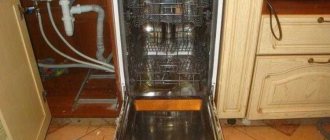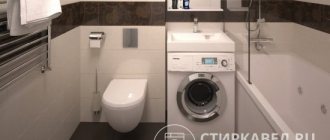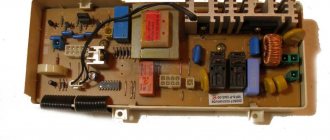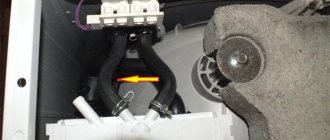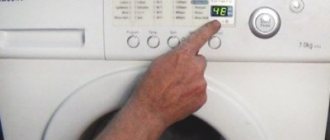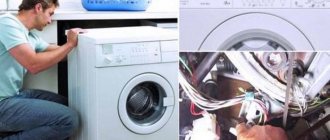Tools and materials for work
For a comfortable and successful cabinet transformation you will need:
- A small adjustable wrench is used to tighten nuts in hard-to-reach areas.
- Screwdrivers - flat, Phillips.
- Roulette - regular, laser.
- Pliers - useful when working with fasteners and communications.
- Drill - make holes in the back wall for the power cord, intake and drain hoses.
- Screwdriver - tighten and unscrew self-tapping screws while working with the frame, curtain wall (built-in PMM).
- Metallized mesh, special film to protect the pencil case from steam.
Such a set of tools can be found in every home. You may also need special materials and parts:
- To connect to the electrical network: a European socket (preferably moisture-resistant), a socket box, about 2 meters of three-core copper wire, a difavtomat, a stabilizer.
- For water supply: triple wiring for water pipe, insulating winding, set of gaskets.
- For the drainage system: siphon with an additional drain pipe, plastic clamps.
Preparing for embedding
Having chosen the ideal size and location of the box, we will begin preparing the installation.
How to make a niche in a kitchen set
Stages of work:
- Remove the doors by disconnecting the side fasteners.
- Unscrew the fasteners and remove the side walls.
- Remove the base and legs.
- Remove the back wall.
- Take additional measurements of the resulting car niche to make sure that it will fit in height and width.
- Connect the inlet hose to the water supply using a tee.
- Attach a drain hose with an additional siphon outlet under the sink.
- Power up the device to perform a test run.
- After successful startup, adjust the legs so that the tabletop is flush above the surface.
This installation option is suitable for a freestanding model. It does not require securing the side walls.
Partial dismantling of the cabinet
This method is suitable if you want to preserve the appearance of the locker:
- Open the doors wide open.
- Remove all shelves, fasteners and partitions.
- If the dishwasher does not fit in height, disassemble the platform to install the device on the floor. The “traces of a crime” will be perfectly hidden by the front panel (“pseudo-base”) - you can attach it with corners under the door after installation.
- Make holes in the back wall for the fence, drain, and power cord.
- Place the machine in the closet.
- All that remains is to connect the communications and turn on the test cycle.
When installing a built-in model, make sure that the future curtain wall does not interfere with opening or closing the door. Adjust the legs and the height of the base in advance.
How to protect your countertop from steam
The dishwasher operates at high temperatures and steam generation is inevitable. High humidity deforms the material over time. Housewives are interested in what they put between the countertop and the dishwasher. Included with the built-in modifications are special rubberized layers. One is placed between the table and the machine, the second - between the door and the hinged facade. This seal is not only moisture-resistant, but also noise-absorbing. If you purchase a device without additional mats, you can buy a special metallized mesh or film for such purposes. Cover the inside surface of the cabinet with protective material.
Machine installation
Installation of the “facade”
To match the design, interior and color of the kitchen, the front side of the doors of all built-in dishwashers is covered with a pre-ordered panel of the required size. To attach it to the car door, the delivery kit includes special fasteners and a template.
Making a custom front panel is not that difficult, but the interior of the room will look neat
The necessary drawings are drawn on a large sheet of paper and the points for attaching parts to the decorative panel are marked, the sheet is applied to it and, using a sharp awl, the points are transferred to the panel, after which the fasteners and door handle are screwed into the marked places with self-tapping screws. Then the panel is fixed to the car doors and screwed to it with self-tapping screws through the holes around the perimeter of the doors.
Tabletop protection
Before installing a dishwasher under the countertop, you need to pay attention to the following. All dishwashers have a not very good design feature - when the doors are opened, steam and moisture from the machine rise up and fall on the lower surface of the countertop, spoiling it.
Some manufacturers create protection against steam and moisture
If the kit does not provide special protection for the tabletop, you should take care of this yourself. You can use special tape, plastic, metal, etc. for protection.
In Bosch models, a special metal plate is attached under the tabletop before installing the machine; in Electrolux, a film made of a special material is glued.
Adjusting the required height
The final installation consists of adjusting the machine to the tabletop using the front and rear legs and leveling it. Then the necessary gaskets are inserted between the side walls of the cabinet and the machine and the walls are attached to each other. The dismantled lower decorative panel, if necessary, is cut off and put in place.
The rules for installing dishwashers require a gap between the rear wall of the machine and the kitchen wall to be at least 50 mm.
Connecting the PMM to the wiring in the kitchen
When connecting kitchen appliances to the network, remember that it is necessary to provide the room with a grounded socket (Euro plug). The dishwasher will work if plugged into a regular outlet, but will not be covered by the warranty.
Basic electrical connection requirements:
- New socket with grounding.
- Distance from the floor is 25–35 cm. This access point was designed by the developers.
- Automatic (16A).
- Stabilizer - protects household appliances from the effects of voltage surges. Some brands (for example, Bosch), most often models with electronic control, fail due to power surges.
Installation procedure for the built-in model
The dishwasher installation algorithm is described in the instructions provided by the manufacturer. Usually it consists of several stages, the first of which is preparatory.
In advance you need to purchase some parts for connecting to the pipes, take care of the socket arrangement, prepare a tool - a screwdriver, a screwdriver, a hammer, as well as flax or fume tape for plumbing connections, sealant, double tape.
Step 1 – checking the PMM equipment
In addition to the dishwasher, the kit usually contains templates for installing decorative trims, fastening tools, a protective rubber apron, gaskets, and hoses.
To make sure everything is in place, you need to find a list of components and check the presence of each of them. If something is missing, you will have to buy more.
The unpacking stage is often carried out in the presence of employees of the company selling the equipment. If problems arise with the packaging, they can be quickly resolved through additional delivery.
Be sure to check if there are installation instructions in Russian. Famous manufacturers duplicate the description of the installation process on official websites in special sections.
We recommend: How to install a window air conditioner yourself
Step 2 - installation in place
Before you begin installing the built-in model, you need to make sure that the cabinet is the right size and that there are holes in its walls for hoses.
Procedure:
- place the machine opposite the niche for embedding;
- pull the drain and inlet hoses through the holes to the connection points, and the power cord towards the outlet;
- carefully push the machine body into the place intended for it and make sure that the length of the hoses suits you;
- pull out the machine and prepare it for installation - carry out the manipulations described in the instructions: glue a vapor barrier film to the inside of the tabletop, attach sealing tapes to the edges, install a mounting plate, damping elements, etc.;
- adjust the height of the legs so that the body stands strictly vertical, check the distance to the walls of the niche with a tape measure;
- Attach noise protection to the bottom part, if included.
Next, you can begin installing decorative overlays. So that they do not differ from the kitchen facade, you can take the removed cabinet door and the panel from the drawer and fix them one by one on the car door, having previously processed and adjusted them to size.
Some tips for installing homemade trims.
Image gallery
Photo from
Keep your kitchen cabinet looking the same as it did before installing the machine. There is no need to order new parts or remove fittings - this way the door looks more natural
In order for the linings to “lay” perfectly evenly on the front panel of the machine, the screws or self-tapping screws for attaching the handles should be recessed by deepening the holes with a drill
Will wooden plastic overlays not move while tightening screws if they are first “planted” with double-sided tape?
The marking stage takes a lot of time, and to reduce it, you just need to use the installation templates offered by the manufacturer
Removing doors and drawers
Reinstallation of accessories for ease of use
Using double-sided tape to secure the pads
Using paper stencils and templates
Usually, to attach decorative overlays, the machine is equipped with long self-tapping screws - they need to be inserted in place of the short ones, which were screwed in initially. When the dishwasher is completely installed, all that remains is to connect the communications and test.
Step 3 - connection to the sewer
This is the easiest and fastest stage. The connection is made in one of two ways:
- insert the drain hose directly into the cuff of the sewer pipe outlet;
- connect the hose to the sink drain system.
The first option is possible if the sewer pipe has a free additional hole, which is located under the sink or not far from it.
Option for integration into a system with a water seal. Regardless of the method, the dishwasher drain hose is equipped with an Aquastop device and a shut-off valve to prevent leaks
For tapping into a pipe, a ¾-inch tee is usually used. If the hose is installed in a siphon, it is better to purchase a special model with an outlet.
Step 4 - connection to the water supply
Even if the model involves connecting to hot and cold water, in Russia it is recommended to supply only cold water. This is due to the impossibility of adjusting the temperature of hot water and the lack of special filters.
Installing a filter for cold water supply is mandatory, otherwise the equipment will quickly fail.
The insertion takes place in the standard way: install a tee and, of course, a shut-off valve. Cutting off the water supply is useful during repairs or replacement of parts
It is better to leave the places of threaded connections detachable, but seal them with fum tape or linen thread. Sealant is used as a last resort; people usually do without it.
Step 5 - Connect to Power
The standard length of the dishwasher power cord is one and a half meters. Therefore, the distance to a separate outlet should be no more than 1.5 m.
It is not recommended to use a filter or extension cord - for the operation of powerful kitchen appliances, according to the rules, separate supply lines must be carefully laid.
It is not possible to lay the electrical cable inside the kitchen walls with a fully installed set, so it is laid in a box or inside the baseboard
To install a separate line, you will need a VVGng copper wire of 2-2.5 mm, a 16 A circuit breaker and a grounded socket.
During installation, repair or maintenance of the dishwasher, the power supply must be turned off. To do this, a separate power line serving the kitchen is turned off at the electrical panel. And if there is no such thing, then they turn off the power to the entire apartment/house.
After installing the dishwasher, it is necessary to check the operation - connect the power supply and activate the machine in test mode in preparation for the first start.
Installing appliances in a finished kitchen is not fundamentally different from conventional installation, but difficulties may arise with connecting communications.
We recommend: Siphon for washbasin: types, selection criteria + assembly rules
Water connection
To organize the water supply, you will need a tee with a faucet, which should be screwed into the place where the cold water pipe flows to the kitchen faucet, under the sink. Such threesomes are sold in plumbing stores. You can choose the size, material, design you need.
How to secure the water supply hose
Connect the water supply hose together with the Aquastop system (if available) to the tee. If the diameter does not match, use an adapter, which is also easy to find on sale.
Do not connect the device to hot water under any circumstances (unless this is permitted by the manufacturer in the instructions). Unsuitable water temperature can cause damage to the temperature sensor and other components.
Which PMM to choose for the countertop
To make your choice, you need to understand the difference between free-standing models and built-in ones.
Characteristics of solo PMM:
- Harmonious, thoughtful design from all sides.
- Various colors.
- Can be placed in any location suitable in size and distance to access points.
- The control panel is located on the top of the door.
- There is no cooling system or thermal insulation.
Features of built-in modifications:
- The side and top panels are made without decoration.
- The device is intended for installation in a cabinet or kitchen niche; a façade of a harmonious tone is hung on the door.
- The buttons are located on the upper border of the door or at the top of the facade.
- Reliable ventilation system, since the equipment is designed to work in a closed space without natural cooling.
Built-in, solo options can be standard sizes (60 cm width) and narrow (45 cm). There are portable, compact, free-standing machines that are convenient for installation under a sink, sink, or on a table.
In order for the purchase to be successful, you should:
- Compare the dimensions of your future assistant with the installation location.
- Decide on capacity - the number of sets that can be loaded at one time.
- Pay attention to the brand’s reputation and the availability of service centers in your locality.
Installation features
It is not difficult to install a PMM if you have a modern kitchen. The cabinets of the new headsets are standard and have space for built-in appliances. So there is no need to modify anything. But if you purchased furniture a long time ago, then there may not be an optimal place to install a dishwasher.
Reference. The most common dishwashers are 45 or 60 cm wide. The height varies.
Installation of PMM in a kitchen set
PMMs are divided into three types:
- Narrow. The width of narrow dishwashers is 45 cm, but in other respects they are not inferior to full-size PMMs. They are the most spacious and can be fully or partially integrated. 6-10 sets are loaded into such machines. They are easy to integrate into the headset. The façade for them is usually purchased separately.
- Compact. Compact PMMs fit only 5 sets. Their width is 60 cm. Such dishwashers are installed in the countertop, under and above the sink in the cabinet.
- Full size. These are the most spacious models. Their height is 90 cm and width 65 cm. They can be built-in or free-standing from the kitchen unit.
A pre-prepared installation diagram will make your task easier.
Manufacturers, leaving space for built-in equipment, focus on the parameters of narrow devices and can add another 10 cm on each side. But if there is no room in the headset, purchase a separate module. It is important that its appearance matches the design of the room. If this does not work, then select a place next to the sink. Before installation, be sure to read the instructions.
The distance from the back wall to the dishwasher should be at least 5 cm. This will ensure good ventilation. If you neglect this rule, the PMM will quickly break.
It is more convenient to install compact dishwashers at chest level. Before installation, pay attention to the type of equipment and its features. The correct location of the unit will save you from problems with its operation.
The optimal place for embedding the PMM is the module that is located with the sink. There will be sewerage and water supply nearby, so there will be no difficulties connecting hoses.
Required tools and materials
Sometimes the instructions for the dishwasher contain a list of tools required for installation. But not all manufacturers provide such information.
Before starting installation, prepare the following:
- screwdriver;
- electric drill or hammer drill;
- chisel;
- screwdrivers;
- pliers;
- hammer;
- level;
- pencil;
- construction square;
- roulette
Screwdrivers should be regular and Phillips. If you have a laser level on your farm, it is better to use it, since a regular one will not be very convenient to work with.
Use only new materials as they are more durable.
Equipment check
Before installation, remove the packaging and check the contents. This is done in the presence of employees of the company where the purchase was made, since not all parts may be included in the kit.
Important! We check that the instructions are in Russian. Without it, it will be problematic to install one or another model of dishwasher.
The kit should include fixing elements, gaskets with hoses and a special rubber apron for protection. Sometimes manufacturers also include parts for installing a decorative trim.
Installation process
Before installation, we check the dimensions of the cabinet again. We carry out the work carefully:
- We place the dishwasher opposite the place chosen for its placement. We make holes in the walls of the cabinet and stretch hoses that are responsible for the flow of water. Let's see if they need to be lengthened.
- We glue the film to the inside of the tabletop to protect the wood from moisture. Next, we fix the tape around the edges for sealing.
- We install damper elements (necessary to eliminate vibration of the dishwasher) and the mounting plate.
- Adjusting the legs. The PMM body must take a strictly vertical position. Using a tape measure, check the distance from the wall of the niche to the edge of the dishwasher.
- Installing a decorative element. It is not necessary to order an overlay; you can make it yourself from cabinet parts. We fix the cover with self-tapping screws.
The kit often includes soundproofing material. Without it, the PMM will make a lot of noise during operation.
How to remodel a cabinet
Procedure:
- First of all, we remove the bottom shelf and dismantle the front plinth.
- We remove the doors. We leave only the side and back walls, as well as the top of the cabinet.
- We attach the PMM to the side walls and tabletop. Fixation is often done with polymer inserts. There should be four of them. They are installed at the top and bottom on both sides. Some machines, for example Electrolux, have only two inserts. They are installed under the countertop.
If there is a solid kitchen countertop, the cabinet is completely dismantled. In this case, the dishwasher will be located between two walls.
Connection to the sewer system
If you are building a dishwasher next to a sink, look to see if there are any free outlets on the siphon that drains liquid from the sink into the drain. If they are not there, buy a siphon with another outlet. This type of connection protects against unpleasant odors and the flow of liquid into the dishwasher from the sewer.
Recommended: Pros and cons of using an air washer
There is another connection method - through a tee. To prevent the smell from the sewer from entering the kitchen, we install a special rubber coupling at the connection between the hose and the tee.
Before starting the PMM, we check all fastenings again. For the first time we turn on the equipment without dishes. We use dishwasher cleaner to clean the appliance. After this procedure, we install the equipment in the cabinet.
Electrical connection
The heating element (tubular electric heater) heats the water in the dishwasher to the required temperature. It is during operation of the heating element that the dishwasher consumes the most energy (2-3 kW).
Based on these parameters, the connection is made to an outlet that can withstand a voltage of at least 16 A. It is placed in two ways: just above the countertop or in a niche next door. Make sure that the distance to the sink is at least 0.5 m, as water may get on it. The socket should be no further than 1 m from the PMM.
A dedicated line runs from the distribution panel to the outlet. If it is not there, they run a wire along the wall and cover it with a special box.
For connection we use a copper multicore cable. Make sure that there is an RCD (residual current device) and switches that will operate at a voltage of 16 A.
Attention! One differential circuit breaker can replace switches and RCDs.
Protective devices must be connected due to the possibility of short circuits. RCD parameters can be 16-25 A, 30 mA. The connection is made the same for all brands of dishwashers.
Connection to water supply
The faucet, which is located in the sink, usually has hoses with cold and hot water. Therefore, it will be convenient to connect the dishwasher in the place where this hose is connected to the water supply. Otherwise, you will have to make an insert into the pipe using a tee. If you connect where the hose connects to the water supply, the shut-off valve can be made under the sink.
A tee with a shut-off valve is necessary to quickly stop the water supply if an emergency occurs. Since almost all dishwasher models only require cold water, we only need one tee.
For installation you will need:
- adjustable wrenches;
- bronze or brass tee with built-in tap (thread diameter - 3/4 inch);
- sharp knife;
- coarse filter (if not included);
- sealing fluoroplastic tape (FUM tape).
If you have a washing machine in the kitchen, instead of a tee, use a manifold with two outlets with the same diameter.
The dishwasher comes with hoses that are a little over a meter long. If this is not enough, you will have to purchase a new hose.
Step-by-step instructions for connecting to the water supply:
- We turn off the water.
- We disconnect the hose that supplies cold water to the mixer from the pipe to the water supply.
- We connect the water supply pipe to a splitter or tee by pre-winding FUM tape onto the thread.
- We connect the outlet of the manifold or tee to the hose that goes to the mixer. We also use FUM tape.
- We connect the filter and the PMM inlet hose to the side outlet.
- We connect the inlet hose of the washing machine (if there is one) to the second outlet.
- We check all connections and let the water flow.
Top 5 best dishwasher manufacturers
The section contains information on which companies you should pay attention to when choosing dishwashing equipment.
Beko
The brand is popular due to its excellent quality, modern innovations, and average price.
Floor-standing full-size Beko DIN 26420:
- Number of programs - 6 pieces.
- Capacity - 14 sets.
- Water consumption - 11 liters.
- Energy consumption - A++.
- Dryer - turbo blower.
The classic design will look stylish both separately and under the countertop. Silent (46 dB), equipped with protection against leaks and children. The height of the internal trays is adjustable - convenient when loading large pots. There is a special compartment for tablets.
Bosch
Famous German brand. It has become synonymous with high quality in the household appliances market. One of the advantages and at the same time disadvantages is the extremely sensitive sensors. They instantly respond to changes in network voltage and water pressure. Therefore, when purchasing equipment of this brand, make sure that there are no periodic power outages or unstable water supply - for the most comfortable operation.
Built-in Bosch SMV44KX00 “Standard” series:
- Modes - 4.
- Capacity - 13 sets.
- Water consumption - 12 l.
- Energy class - A.
- Drying - condensation.
Equipped with functions for loading capsules, tablets, connecting hot and cold water, and a projection beam notifying the end of the cycle. There is also a turbidity sensor and a delay start.
Candy
The Italian brand specializes in high quality new technologies, focusing on simplicity and ease of use.
Narrow, fully built-in Candy CDI 2D10473-07:
- Programs - 7.
- Loading sets - 10.
- Uses water per cycle - 9 liters.
- Energy consumption - A++.
- The dryer is condensing.
Economical model with a cleanliness sensor that determines whether additional rinsing is required. Plus protection against leakage, a sound signal for the end of the cycle, and information output on a digital display.
Electrolux
ESF 2300 DW - this compact partially built-in PMM from the Electrolux brand can also be successfully fitted under a countertop. This model, like other Electrolux options, is characterized by high energy efficiency, stylish design, and pleasant colors.
Other features:
- 6 washing modes + 4 temperature settings.
- Holds 6 sets.
- Uses only 7 liters per cycle. Energy consumption - A.
- Condensation dryer.
- The machine is equipped with detergent indicators, partial leakage protection, and a delayed start of up to 19 hours.
Advantages:
- High-quality washing of the highest class A.
- Durability (there are reviews confirming a 10-year service life).
- Low noise - only 48 dB.
- There is a water purity sensor.
- You can use 3-in-1 products.
Minuses:
- The filtration mesh does not work well, the nozzles become clogged with food debris.
On a note! Experts recommend not loading completely dirty dishes into any dishwasher - it is advisable to clean the plates from food debris with at least napkins or a damp sponge.
- There are leaks (after all, the protection is partial, not complete).
